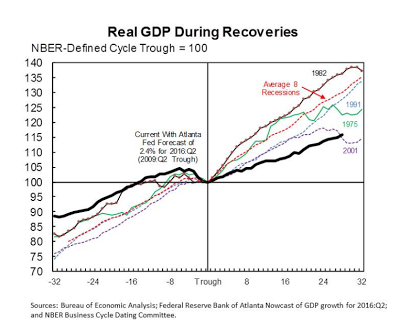Is the U.S. Economic Recovery about to Speed Up?

Please note that we are not authorised to provide any investment advice. The content on this page is for information purposes only.
This Great Graphic was tweeted by Alan Kruger (@Alan_Kruger). Drawing on official data and the Atlanta Fed’s GDPNow tracker for Q2 GDP (2.4%), it shows the current business cycle in the context of a four earlier cycles.
Until now, the recovery from the Great Financial Crisis was the weakest from the post-WWII last four contractions. However, as Kruger points out assuming that the Atlanta Fed’s GDP tracker is accurate, this dour assessment will no longer hold. It will surpass the recovery from the end of the tech bubble at the start of the century.
This Great Graphic was tweeted by Alan Kruger (@Alan_Kruger). Drawing on official data and the Atlanta Fed’s GDPNow tracker for Q2 GDP (2.4%), it shows the current business cycle in the context of a four earlier cycles.
Until now, the recovery from the Great Financial Crisis was the weakest from the post-WWII last four contractions. However, as Kruger points out assuming that the Atlanta Fed’s GDP tracker is accurate, this dour assessment will no longer hold. It will surpass the recovery from the end of the tech bubble at the start of the century.
Even so, the recovery in many respects remains unimpressive. Nevertheless, it is notable in what it says about the two main competing explanations for the lackluster growth.
One camp argues that as financial crisis (balance sheet crisis); it takes longer to recover than from a traditional end of a business cycle. However, from that perspective, the US economy has recovered faster than anticipated. When the history of this period is written, the early and aggressive action by the Federal Reserve (with the Treasury Department) was a big reason why a Great Depression was avoided.
The other camp argues that the lackluster recovery is due to secular stagnation. Insufficient aggregate demand has become the normal condition. Serial bubbles have hidden it. However, when looking at that chart, it is difficult to say the US economy is stagnating.
The US economy has never been bigger. It may be growing slowly, and some of the headwinds, like the less supportive demographics, will be with us for some time, but stagnation is not a fair description of the heavy black line on the chart.
Part of the problem is productivity growth has slowed, and economists, let alone policymakers, do not fully understand the causes.
Great Graphic: How the US Recovery Stacks Up is republished with permission from Marc to Market





